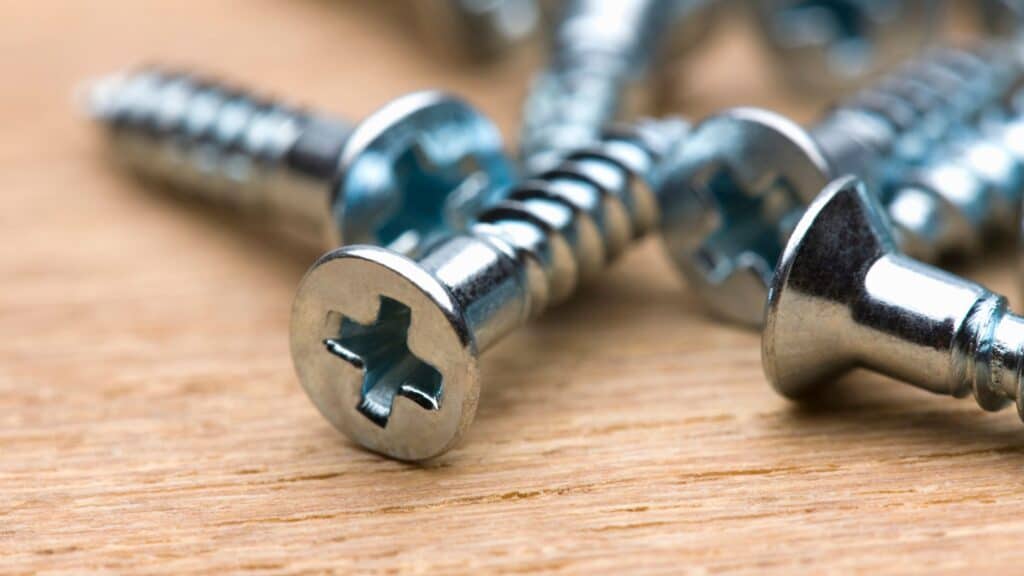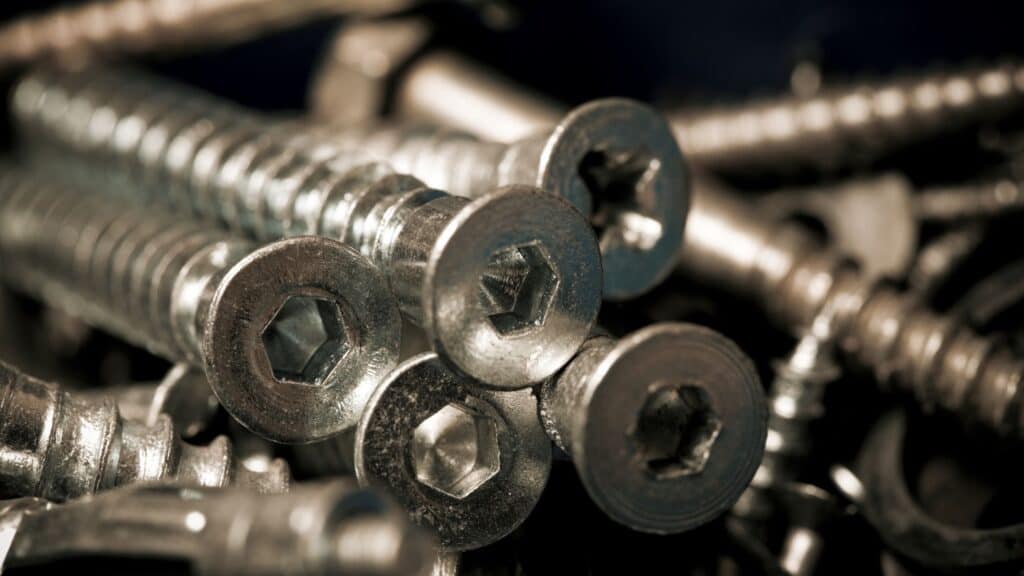As a do-it-yourselfer, you will be able to find the information you need to select the main types of screws for your job in this article.
There are many different types of screws available for use. But what should you watch out for when choosing the screws?
Each one has been meticulously engineered for use with different materials and surfaces. Using the wrong one for your project could be a disaster. In other words, you’ll be screwed.
What Types Of Screws Are There? The Right Screw For Every Material
The various screws differ depending on the situation and the material they are used for. The field of application of the screws is determined by the:
- Material
- Thread
- Head
- Drive
- Class
Screw point types differ significantly in the material for which they are made. The main types of screws based on areas of application are:
Wood Screws
Wood screws have a self-tapping double thread and, as the name suggests, are suitable for screwing wood. The material of the wood screws is mostly galvanized steel. This often has a yellowish-bluish discoloration due to corrosion protection.
For screw connections that are exposed to the weather, you should use stainless steel wood screws. Depending on the wood material and the tips of the screws, it may be the case that you have to drill the screws for wood.
Threaded Screws
All screws that are fastened with a nut must have a metric thread. That is why they are called threaded screws. Metric threads are also called ISO, standard, normal, or V-threads. They are made of metal.
The outer edges of the screw threads converge in a cone shape so that they cannot come loose on their own. Threaded screws are also available with a fine thread. It is narrower and the thread profile is cut less deeply.
Metal Screws
You use this type of screw if a metal is to be screwed. Metal screws have a regular thread and a cylindrical shape. They are either screwed into the material individually (especially if they have a fine thread) or they are additionally fastened with a nut. Metal screws are available as drilling screws or self-tapping screws.
Self-tapping screws have a hard special thread. They typically have a drill point and can be drilled directly into the material. If you want to connect wood to metal, a metal screw with a countersunk head and milled ribs is suitable. This gets into the wood without pre-drilling and the wings of the screw break off as soon as it is drilled through the metal and gets a firm hold.
Caution: Screws without a drill bit must be pre-drilled, otherwise you can quickly slip off when drilling in sheet metal.
Strength Class For Screws: What Does This Express?

The types of screw ends also differ in their different strengths, depending on the screw model. The strength class indicates how stable the connection is, which was made by the screw and where it is used. The most common strength classes are:
- 4,6
- 8,8
- 12,9
The number before the comma is the tensile strength and the number after the comma is the yield point. Tensile strength indicates the maximum stress that the screw can absorb. If this is not observed and the screw is subjected to too much tension, the screw head may tear off and the rest of the screw will get stuck in the material. The tensile strength is calculated as follows:
Strength class 4,6 = 4 x 10 = 400 N/mm².
The yield point is reached when the metal has been stretched so much that it cannot return to its original shape. The yield point is calculated as follows:
Strength class 4,6 = 4 x 6 x 10= 600 N/mm².
A Quick Look At Screw Threads
Screw threads are mainly divided into metal threads and wood threads. However, there are other thread types. The most commonly used 3 types of screws are:
1. Wood Thread (Coarse Thread)
Thanks to the coarse thread, you can use these screws to drill through the (softer, but splinter-prone) wood particularly well.
2. Metal Thread (Fine Thread)
Due to the narrower thread, these screws can be better drilled into solid materials, such as metal.
3. Metric Threads (Coarse Threads Or Fine Threads)
Fine threads are best suited for drilling through metal. Coarse threads are particularly suitable if you want to drill through wood.
Types Of Screws: Head Differs By Shape

Screw types differ not only in the manner in which they are used. The screw head shape is also crucial for handling the screws. Screw types are often simply named after their head shape. The most common models are:
- Flat-headed
- Button head
- Countersunk
- Hammerhead
- Cylinder head
- Eyebolt screw
- Carriage bolt (Schlossschraube)
There are practical as well as aesthetic reasons for the different screw head shapes. For example, a countersunk head screw is usually used for screwing in wood. These can be flushed with the material or countersunk, and then the screws can be filled. Pan head screws are often decorative, made of brass or burnished, and are commonly used for fittings or baseboards.
A carriage bolt has a square neck under the head, preventing the bolt from loosening when tightening a nut. Eye bolts and hook-head bolts provide an eyelet to attach things to. This is especially useful for attaching clotheslines, ceiling lights, and similar things. Hopefully, by now, you have a better idea of how to choose the right screw for your job.
Types Of Heads On Screws: What Types Of Screw Heads Are There?
Another distinguishing feature of different types of screws is the head drive. Here are the most commonly used 5 types of screws:
- Slotted screw
- Phillips screw
- Hex bolt
- Square head screw
- Torx screws (inner star drive)
Each screw has its advantages and disadvantages when mounting. Hexagonal socket screws, i.e. where the hole for the screwdriver goes inwards into the screw, are quite cheap and easy to use. But they require lateral space for tightening. With an external hexagon, a wrench must be used, and the power transmission is worse here than with a screwdriver.
Pozidriv screws (PZ screws) have slight star lines in addition to the Phillips. Phillips screws (PH screws) have a slight disadvantage compared to PZ screws, as the PZ screws do not slip sideways so easily.
A good rule of thumb is that the larger the drive surface of a screw, the easier it is to screw. Six-round screws offer good power transmission and can also be screwed in easily with a small tool and do not need a lot of contact pressure.
